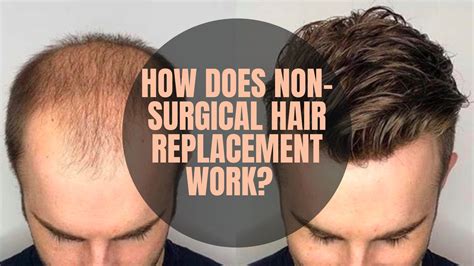Introduction

Hair loss is a common concern for men of all ages, affecting millions worldwide. While some embrace their baldness, others seek solutions to restore their youthful appearance and boost their confidence. Non-surgical hair replacement methods offer a viable and often transformative option for men looking to address their hair loss.
Understanding Hair Loss in Men
Male pattern baldness, also known as androgenetic alopecia, is the most common form of hair loss among men. It is caused by a combination of genetic predisposition and the influence of the hormone dihydrotestosterone (DHT). DHT binds to hair follicles, causing them to shrink and produce thinner, weaker hair until eventually, they stop producing hair altogether.
Non-Surgical Hair Replacement Options
Numerous non-surgical hair replacement methods are available for men, each with its own advantages and disadvantages. The most popular options include:
-
Hairpieces: These are pre-made hair units that are attached to the scalp using adhesive or clips. Hairpieces come in a variety of styles and colors to match natural hair.
-
Toupees: Similar to hairpieces, toupees are smaller units that cover only a portion of the scalp, such as the crown or temples.
-
Hair extensions: Strands of human or synthetic hair are attached to existing hair to add volume and length.
-
Scalp micropigmentation: This procedure involves implanting tiny dots of pigment into the scalp to create the illusion of hair follicles.
Factors to Consider When Choosing a Non-Surgical Hair Replacement Method
When selecting a non-surgical hair replacement method, men should consider several factors:
-
Lifestyle: Active individuals or those who sweat heavily may find it challenging to maintain certain hair replacement methods.
-
Budget: Hair replacement can vary in cost, so it is essential to establish a budget before exploring options.
-
Personal preferences: Some men prefer the convenience of hairpieces or the long-lasting results of scalp micropigmentation.
Pain Points and Motivations for Men Seeking Hair Replacement
Men who seek hair replacement often experience pain points such as:
-
Loss of confidence: Hair loss can lead to feelings of inadequacy and decreased self-esteem.
-
Social stigma: Baldness is sometimes associated with aging, ill health, or lack of masculinity.
-
Missed opportunities: Hair loss can limit opportunities in personal and professional life.
Motivations for men considering hair replacement include:
-
Improved appearance: Hair replacement can restore a youthful and confident appearance.
-
Boosted self-esteem: Regaining lost hair can enhance overall well-being and self-worthiness.
-
Professional advancement: A well-groomed appearance can positively impact career prospects.
Pros and Cons of Common Hair Replacement Methods
Table 1: Pros and Cons of Hairpieces
| Pros | Cons |
|---|---|
| Easy to apply and remove | Can be expensive |
| Versatile styling options | Can be noticeable if not applied properly |
| Requires regular maintenance | May not be suitable for active individuals |
Table 2: Pros and Cons of Toupees
| Pros | Cons |
|---|---|
| Cover only a portion of the scalp | May be difficult to blend with natural hair |
| Less noticeable than hairpieces | Requires careful application and removal |
| Can be more expensive | May not be suitable for long-term use |
Table 3: Pros and Cons of Scalp Micropigmentation
| Pros | Cons |
|---|---|
| Permanent results | Requires multiple sessions to achieve desired results |
| Low maintenance | Can be time-consuming |
| Does not require surgery | May not create a perfect match to natural hair |
Table 4: Pros and Cons of Hair Extensions
| Pros | Cons |
|---|---|
| Add volume and length to natural hair | May damage existing hair if not applied properly |
| Can be styled and colored like natural hair | Requires regular maintenance |
| Relatively affordable | Not suitable for all hair types |
Future Advancements in Non-Surgical Hair Replacement
Researchers continue to explore innovative hair replacement technologies and treatments. Some promising advancements include:
-
Bioengineered hair follicles: Scientists are developing methods to grow hair follicles in the laboratory and transplant them onto the scalp.
-
Tissue engineering: Using scaffolds and growth factors, researchers aim to regenerate scalp tissue and promote hair growth.
Conclusion
Non-surgical hair replacement offers men a range of options to address their hair loss and regain their youthful appearance. By understanding the pain points and motivations associated with hair loss and carefully considering the available methods, men can make informed decisions that empower them to feel confident and look their best. As innovations continue to emerge, the future of non-surgical hair replacement holds even greater possibilities for restoring natural hair growth and enhancing overall well-being.
